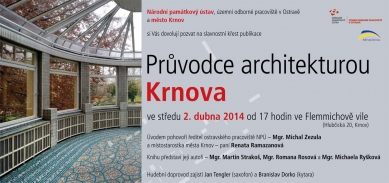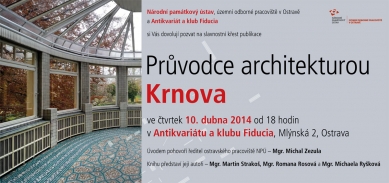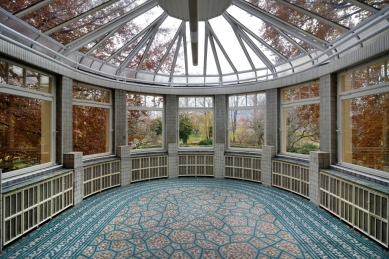
Guide to the Architecture of Krnov - Invitation to the Book Release
The Ostrava National Heritage Institute has published another publication – A Guide to the Architecture of Krnov. The baptism in Krnov will take place on April 2, 2014, at 5 PM at Flemmich's villa (Hlubčická 20). The baptism in Ostrava will take place on April 10, 2014, at 6 PM at the Antiquarian Bookshop and Club Fiducia (Mlýnská 2). The publication will be presented by the head of the authors' team - Mgr. Martin Strakoš. The authors - Mgr. Romana Rosová and Mgr. Michaela Ryšková will also be present.
The book A Guide to the Architecture of Krnov, published by the National Heritage Institute, Regional Professional Workplace in Ostrava, follows the previous volumes in the edition – A Guide to the Architecture of Ostrava (2009) and A Guide to the Architecture of Opava (2011). The team of authors, led by Martin Strakoš and represented by co-authors Romana Rosová, Michaela Ryšková, photographer Roman Polášek, graphic designer Martin Feikus, and with editorial support from Petra Batková, has prepared a volume aimed at presenting architectural monuments and other valuable architectural works from the founding of the city in the 13th century to the present day to both lay and professional audiences. A secondary ambition of the volume is, through education and the gathered textual and visual information, to build upon previous research and contribute to the preservation of local architectural culture values for the future. The book was financed from institutional support from the Ministry of Culture for the long-term conceptual development of the research organization and with financial contributions from the city of Krnov.
At the beginning of the publication, there is a brief overview of the development of architecture and urbanism in the area of Krnov from prehistoric times to the present day. Following this is the central part of the guide, based on a structured catalog with 184 entries. The catalog contains 143 small and 41 large entries, capturing architecturally valuable objects or areas at two levels of detail. The entries are composed of basic localization, temporal, and personal information, a brief characterization, a photograph, and a plan. The selection of buildings was guided by several criteria. The authors of the publication took into account primarily the architectural and art-historical qualities of the buildings, their role in the overall image of the city, or whether they represent a certain stage or stylistic layer of Krnov's development. An important aspect was also the historical significance of each individual object, even if its architectural value may have been diminished by subsequent interventions. This is the case for some industrial complexes, whose significance for the history, urbanism, and architecture of the city is undeniable, despite their dilapidated condition.
In addition to buildings by prominent figures of Central European architecture, such as Leopold Bauer, Otto Prutscher, or Leo Kammel, the publication records works by local builders and architects such as Josef Hartel, Ernst Latzel, Eduard Frank, Franz Blasche, Eugen Koch, as well as creators from surrounding Silesian areas and Moravia (e.g., Otto Reichner from Opava, Karl Fischer from Olomouc). The Guide also includes construction realizations from the difficult periods of modern history, namely from the era of the rise of Nazism in neighboring Germany and the subsequent German occupation of Krnov or from the communist regime from 1948 to 1989. The publication also features architecturally significant buildings from recent years, such as the K3 tennis hall. The publisher and authors believe that the book will become a useful tool for discovering the values of the city's heritage and building stock and for the development of the region's architectural culture.
The publication can be purchased at the library of the Ostrava workplace of the National Heritage Institute (Korejská 12, Ostrava) for the price of 390 CZK.
The book A Guide to the Architecture of Krnov, published by the National Heritage Institute, Regional Professional Workplace in Ostrava, follows the previous volumes in the edition – A Guide to the Architecture of Ostrava (2009) and A Guide to the Architecture of Opava (2011). The team of authors, led by Martin Strakoš and represented by co-authors Romana Rosová, Michaela Ryšková, photographer Roman Polášek, graphic designer Martin Feikus, and with editorial support from Petra Batková, has prepared a volume aimed at presenting architectural monuments and other valuable architectural works from the founding of the city in the 13th century to the present day to both lay and professional audiences. A secondary ambition of the volume is, through education and the gathered textual and visual information, to build upon previous research and contribute to the preservation of local architectural culture values for the future. The book was financed from institutional support from the Ministry of Culture for the long-term conceptual development of the research organization and with financial contributions from the city of Krnov.
At the beginning of the publication, there is a brief overview of the development of architecture and urbanism in the area of Krnov from prehistoric times to the present day. Following this is the central part of the guide, based on a structured catalog with 184 entries. The catalog contains 143 small and 41 large entries, capturing architecturally valuable objects or areas at two levels of detail. The entries are composed of basic localization, temporal, and personal information, a brief characterization, a photograph, and a plan. The selection of buildings was guided by several criteria. The authors of the publication took into account primarily the architectural and art-historical qualities of the buildings, their role in the overall image of the city, or whether they represent a certain stage or stylistic layer of Krnov's development. An important aspect was also the historical significance of each individual object, even if its architectural value may have been diminished by subsequent interventions. This is the case for some industrial complexes, whose significance for the history, urbanism, and architecture of the city is undeniable, despite their dilapidated condition.
In addition to buildings by prominent figures of Central European architecture, such as Leopold Bauer, Otto Prutscher, or Leo Kammel, the publication records works by local builders and architects such as Josef Hartel, Ernst Latzel, Eduard Frank, Franz Blasche, Eugen Koch, as well as creators from surrounding Silesian areas and Moravia (e.g., Otto Reichner from Opava, Karl Fischer from Olomouc). The Guide also includes construction realizations from the difficult periods of modern history, namely from the era of the rise of Nazism in neighboring Germany and the subsequent German occupation of Krnov or from the communist regime from 1948 to 1989. The publication also features architecturally significant buildings from recent years, such as the K3 tennis hall. The publisher and authors believe that the book will become a useful tool for discovering the values of the city's heritage and building stock and for the development of the region's architectural culture.
The publication can be purchased at the library of the Ostrava workplace of the National Heritage Institute (Korejská 12, Ostrava) for the price of 390 CZK.
The English translation is powered by AI tool. Switch to Czech to view the original text source.



0 comments
add comment




